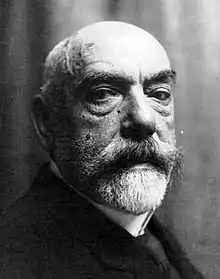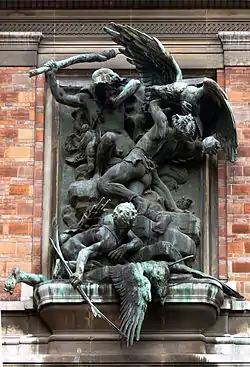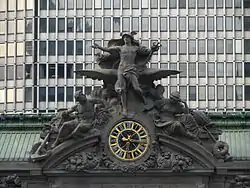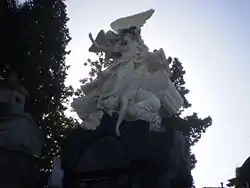Jules Coutan
Jules-Félix Coutan (22 September 1848 – 23 February 1939) was a French sculptor and educator.
Jules Coutan | |
|---|---|
 Coutan in 1923 | |
| Born | 22 September 1848 Paris |
| Died | 23 February 1939 (aged 90) Paris |
| Nationality | France |
| Known for | sculpture |
| Awards | Prix de Rome |



Life
As a student at the École des Beaux-Arts, Coutan was awarded the Prix de Rome in 1872; after his return to Paris he executed the fountain group France Bearing the Torch of Civilization for the Exposition Universelle (1889), one of the two prominent sculptural commissions for the exposition grounds.[1] Later he taught at the École des Beaux-Arts from 1900, where he expressed his disdain for the researches of Rodin (as fumiste[2]) and the Impressionist sculptors who followed him. He was elected to the Académie des Beaux-Arts in 1905.[3]
Coutan is best known in the United States for the sculptural group above the entrance to Grand Central Terminal in New York City. For Grand Central Terminal, Coutan was contracted to provide a quarter-size scale plaster model of the three-figure allegorical Transportation group, which he developed from 1911 through 1914. (Coutan never visited the U.S.) The carving was performed by the William Bradley & Son of Long Island City.[4]
The small bronzes, some stamped by the founders Thiebaut Frères, that represented a constant source of income for Coutan and a genre typical of his output, appear with some frequency on the art market.[5]
Among Coutan's students were Hippolyte Lefèbvre, Raymond Delamarre, and the Argentine sculptor Rogelio Yrurtia.
Work
- fountain group France Bearing the Torch of Civilization for the Exposition Universelle (1889)
- caryatids for the Opéra-Comique, Paris, 1899
- reliefs Science and Labor for the Pont de Passy (now the Pont de Bir-Hakeim), Paris
- bas-reliefs for the polychrome terra-cotta facade in the Square Félix-Desruelles, with architect Charles Risler, for Sèvres Porcelain,[6] circa 1900
- figure of La France de la Renaissance for the Pont Alexandre III, circa 1900
- high relief, The Eagle Hunters for the facade of the Muséum national d'histoire naturelle in Paris; also the plaster model at the Musée d'Orsay (1893–1900);[7] bronze cast (1900), installed
- Glory of Commerce group for Grand Central Terminal, NYC, 1914
- the bust of Georges-Eugène Haussmann at the Père Lachaise Cemetery
- Franco-Prussian War Memorial, Poitiers
- angel figures for the José C. Paz tomb, La Recoleta Cemetery, Buenos Aires, Argentina
References
- On the theme of a linear progress of humanity displayed at the Exposition, Pascal Ory remarks, "ce n'est évidemment pas un hasard si les deux principales commandes de l'Expo en matière de statuaire ont été consacrées respectivement à une 'Fontaine du progrès' (Coutan) et à un groupe intitulé officiellement 'La Nuit essayant d'arrêter le génie de la Lumière qui s'efforce d'éclairer la Verité'." (P. Ory, L'Expo universelle, 1889, 1989:20f).
- Claire Maingon, "Les effets de la Grande Guerre sur la carrière d'un jeune sculpteur", Emulations, 2007; French fumiste signifies one who is not serious.
- K. S.-D.: "Coutan, Jules Félix (Jules)", in: Allgemeines Künstlerlexikon, vol 22, p. 21
- "WORLD'S LARGEST SCULPTURE GROUP FOR NEW YORK; Figures for Grand Central Station Are 50 Feet High" (PDF). The New York Times. 1914-06-14.
- Examples: Standing Cupid, 1875; Union of Work and Peace, 1893, presented to Louis Lemoine by his employees; further examples.
- https://www.flickr.com/photos/iainmclauchlan/4190804607/
- illustrated Archived 2009-11-15 at the Wayback Machine
"Jules-Felix Coutan on artnet". Retrieved 2007-11-26.
| Wikimedia Commons has media related to Jules Coutan. |
External links
- Jules Coutan in American public collections, on the French Sculpture Census website
